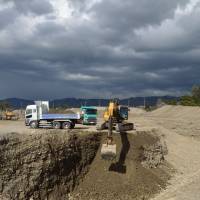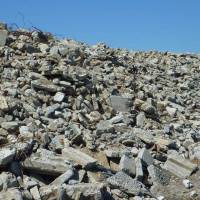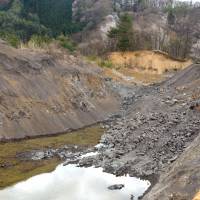Where does concrete come from? The material has become such a pervasive symbol of human alienation from nature that it's tempting to assume it's just another brutish product of the 18th-century Industrial Revolution. In actuality, the Romans used very similar stuff more than 2,000 years ago — made, then as now, from gravel, rocks, sand, water, limestone and other additives.
Concrete, in other words, depends unavoidably on massive extraction of natural materials from the earth. "The city and the limestone quarry are like the positive and negative of the same photograph," the renowned photographer of quarries and concrete Naoya Hatakeyama has said. The same could be said for every one of the highways, sea walls, dams and tetrapods in Japan, which is one of the most concrete-covered countries in the world.
Annual concrete production peaked here in 1990 at nearly 200 million cu. meters. Soon after that the economic bubble burst, and annual production gradually fell to under half that amount. (China now dominates global concrete use.) It's a trend that may soon change.
For one thing, public-works-friendly Prime Minister Shinzo Abe has, to the delight of construction interests, returned to power. Concrete production looks poised to surge.
In coastal areas of Honshu's northeastern Tohoku region use of the material is already booming for another reason: reconstruction from the huge tsunami that devastated the region in 2011.
"We're seeing demand two or three times the average," said a representative of the Ready-Mixed Concrete Industrial Association (RCIA) in Iwate, one of the tsunami-ravaged prefectures. "Ships are bringing gravel from Aomori and Hokkaido. Concrete factories have taken on staff and bought more trucks. Production is going at full tilt."
The same is true to the south in adjoining Miyagi Prefecture, as Kiyoshi Hosokawa, secretary of its RCIA, reported. Up to nine new concrete-making plants will likely be built on the coast to meet soaring demand for roads, sea walls and buildings, he said.
Meanwhile, Prime Minister Abe's Liberal Democratic Party (LDP) plans to submit a bill to the Diet soon that would boost spending on infrastructure nationwide. It's the centerpiece of the party's National Resilience Plan, which calls for ¥200 trillion investment over 10 years in tsunami-proof cities, new roads and better sewers, among other things, to protect against natural and manmade disasters. However, critics claim this is merely a reversion to the LDP's traditional policy of pork-barrel spending on concrete structures. The LDP returned to power last year after defeating the Democratic Party of Japan — one of whose slogans, "From Concrete to People," had signaled its aim of rechanneling spending into social welfare.
So where does all this concrete come from? Dismembered mountains, mostly, since it is made by mixing gravel or crushed rock and sand (together called "aggregate") with water and cement. The latter material, which acts like glue, is made by crushing and heating limestone, clay, and other minerals. Cement production contributes about 8 percent of annual global emissions of the greenhouse gas carbon dioxide, according to a 2012 European Commissions report.
Because aggregate is heavy and expensive to transport, and limestone is naturally abundant in Japan, nearly all of the materials used in concrete are sourced domestically. Back when the postwar recovery was taking off in the 1950s, most of the aggregate used was river gravel. But riverbeds were soon severely depleted and the government placed strict limits on further exploitation. Quarrying firms then turned to mountains, fields and seashores. Today, crushed rock comprises the vast majority of aggregate, with gravel and sand making up the rest.
But like river gravel, overexploitation of sand from the Seto Inland Sea for aggregate led to extraction bans in the 1990s. After that, attention shifted to the possibility of reusing aggregate from demolished concrete structures. Today, however, only about 1,000th of the aggregate in concrete is from recycled sources — which the Affairs Council of Recycled Aggregate claims is due to legal, not technical reasons. Specifically, such material is not on the official list of approved materials for use in public-works projects.
In Tohoku, there were a number of proposals following 2011's Great East Japan Earthquake and tsunami to incorporate crushed disaster rubble into concrete for the reconstruction. That has not happened.
"To reuse concrete rubble as aggregate, quite a lot of processing needs to happen to meet national quality standards. I think that's become a big obstacle," says Tohoku University civil engineer Makoto Hisada.
In Iwate, ancient riverbeds buried under centuries of accumulated earth now yield a lot of the gravel for reconstruction. Mining buried riverbeds is also common where I live in central Nagano Prefecture, so I stopped by my local gravel cooperative association to see how it's done.
Motoyasu Kawabe, the affable office director, met me at the co-op's headquarters in a dusty complex of gravel sorting and processing plants on the outskirts of the city of Matsumoto. Over coffee, the former banker explained that high-quality gravel deposits lie hidden beneath rice paddies, vegetable fields, and building lots on the valley floor. Extraction companies search them out through a combination of experience and luck.
We headed out to see one rice paddy in the midst of excavation. Now two 10-meter-deep pits gape in the middle of the field, ministered over by a fleet of dump trucks and bulldozers. Over a one-year period, about 80,000 cu. meters of rock and dirt will be removed and graded, then sent for use in concrete, as a bed under roads and at construction sites. Although neighbors often complain of noise and dust, Kawabe said there's no shortage of landowners willing to offer a field or two in exchange for the handsome extraction fee.
"After we're done we'll fill the dirt back in and you'd never know we've been here," he said. But where does close on 80,000 cu. meters of infill for this site come from?
Kawabe slid back behind the wheel of his car and headed up into the lushly forested mountains to the east of the city to show me. After about 15 minutes he turned onto a narrow road down which a barren, gaping hole in the forest suddenly came into view. Over 10 years, half a mountain has been carved away and trucked off to fill in holes dug in the valley floor. Though the site is nearly exhausted, a few power shovels were still scraping at its tawny surface.
On one edge of the site, stagnant water filled the bottom of a pond. Rain inevitably erodes dirt from the exposed mountainside, and this pond was dug so the muddy water could collect there and settle before running off. Kawabe said that eliminates the threat of sediment degrading nearby stream and river ecosystems.
That may be true here, but in the city of Owase, on the Mie Prefecture coast, runoff from rock quarries is the prime suspect in a serious environmental problem.
"When there's heavy rain, the water flowing into the rivers becomes muddy. This flows into the bay and harms the seaweed and fish farms. We believe it's the result of many years of quarry development (in the watershed)," said Masashi Nakamoto, general affairs director of the Owase Fisheries Cooperative. The co-op is currently suing the prefectural government to prevent it granting permission for any new quarries.
Exacerbating the problem is the fact that Owase's annual rainfall of 3,850 mm is one of the highest in Japan, and over the years drinking water sources have been muddied, too. Last year, 15,000 of its 20,000 residents signed a petition calling for permission to be withheld for any more quarries.
Though Owase's problems are due to a combination of geography, climate and resource use — not just gravel extraction — they are a reminder of photographer Hatakeyama's message that concrete comes at a cost to the natural world. Japan's politicians and bureaucrats would be wise to remember that as they press on into a new era of public-works spending.





















With your current subscription plan you can comment on stories. However, before writing your first comment, please create a display name in the Profile section of your subscriber account page.